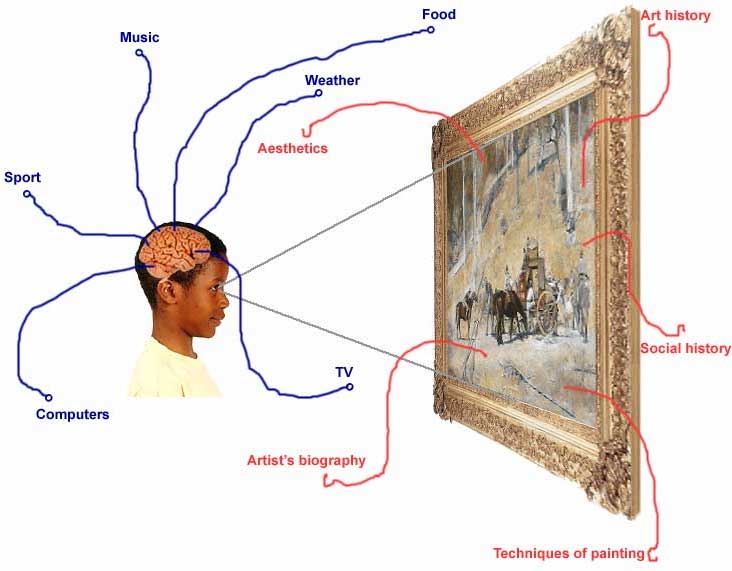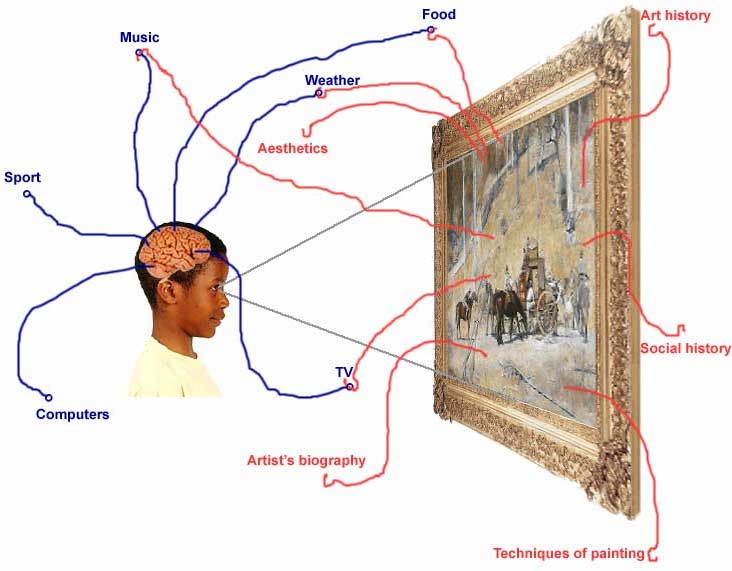(Notes for parents, and teachers, who want to help their children appreciate art)
Let’s have some fun with this semi-abstract painting, by John Olsen.

Entrance to the seaport of desire 1964
© the artist 2009
Collection AGNSW
- Imagine you are walking through the painting with bare feet. How does it feel?
- Imagine the painting is a person. What is its favourite sport?
- How would it escape from the Gallery?
- What kind of animal would it be?
- What would the forecast be for this painting?
- What would this painting taste like if you could eat it?
- What music would go well with this painting?
- What kind of TV show would this be? (And do you think you’d watch it?)
Having fun with art has a serious side
Why play games with art, like asking what a painting would taste like, or how would it talk?
1. It’s fun, and our first aim is that our children will want to spend time with art.
2. It’s participatory. It’s no secret that experiences are more meaningful and memorable if they are active, rather than passive.
3. It helps make connections between the artwork and the viewer’s life. You might think that to really appreciate a work of art, one needs to study the historical context and learn about the life of the artist. But if someone looking at an artwork has a set of interests and concerns with nothing in common with these kinds of things, no connection will occur:

If, on the other hand, we can discover some other ‘hooks’ in an artwork, the process of art appreciation can begin:

And, eventually (even if it takes months or years), the young viewer may grow some new interest ‘loops’ and connect with those more traditional art history ‘hooks’.
4. Imaginative games (particularly ones involving crossing the senses, such as ‘What music would go well with this artwork?’) are very good at bypassing our reticence to talk about feelings. Ask someone “How does this painting make you feel?” and you will probably get a half-hearted answer. If, however, you asked, “What food might this be?” and you got the answer, “Slimy octopus”, that would be a useful indication of a strong emotional reaction. The best path to someone’s feelings is often the indirect one. At the bottom of this page are some more suggestions for imaginative questions.
Don’t close the door too early
Two common questions that people ask children in front of artworks are: “Do you like this?” and “Which one is your favourite?” While it is good to encourage participation, making a value judgement too soon is like closing a door. Even if the answer is “Yes, I love it!”, it tends to stifle any further investigation or playfulness. Of course, sometimes it’s unavoidable, particularly when the initial response is negative: “Is this supposed to be art?” or “How much did the Gallery pay for this?!”. In this case, try to work with those initial reactions, to see if you can prise the door open a little longer. You (and/or your child) may still end up not liking the artwork but, believe it or not, it is possible to ‘dislike’ an artwork but still enjoy looking at it and thinking about it. Remember, artists are real people. It’s easy to be over-awed by an artwork and by the ‘genius’ of a great artist (or the obscurity of an avant-garde artist). We can forget that there was once a time when this artwork didn’t exist and that the artist had to make some decisions. Imaginatively re-enacting an artwork (thinking what might have been going through the artist’s mind and how the artwork might have been created) is a good way to connect with it. But be prepared for some surprises!
More imaginative questions
- “This photograph is called ‘The parade’. Give it three new titles: one funny, one tragic, one strange.”
- “Give a weather report for this landscape painting.”
- “Imagine that this sculpture is going to escape tonight. How would it move? Would it klunk? Slither? Glide? Jog? Charge? …”
You can even use these kinds of questions at other kinds of museums. Eg:
Historic house
- “How would this room change if [Amy Perry] were living here?”
- “How would you change this room if you were living here?”
Zoo
- “Match each of these animals with one of these celebrities…”
- “What sport would each of these animals be best at?”
Transport museum
- “How could you turn this bus into a submarine?”
- “The nickname for this kind of tram was ‘toast-rack’. What would be a good nickname for this truck?”